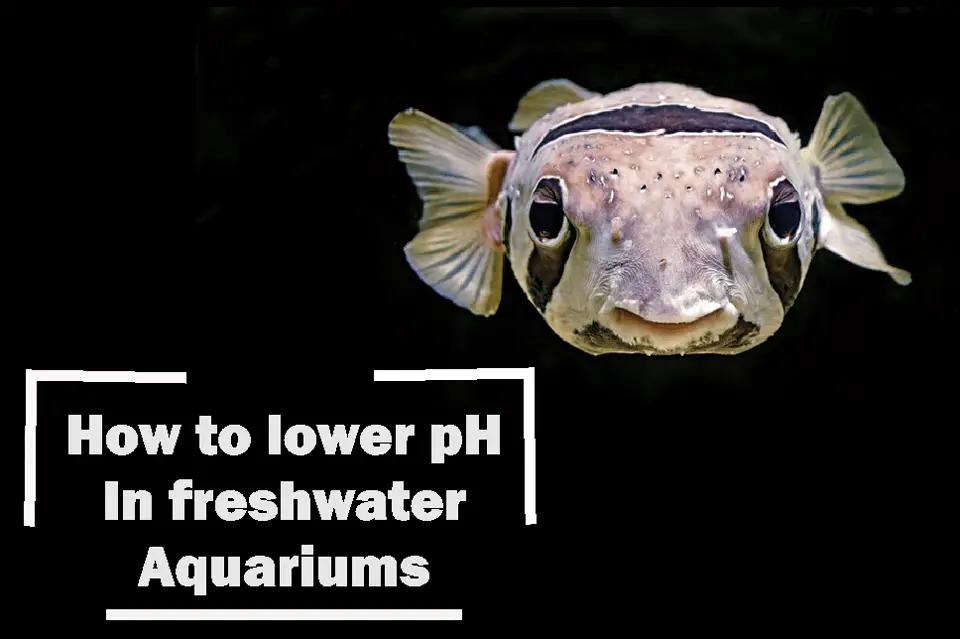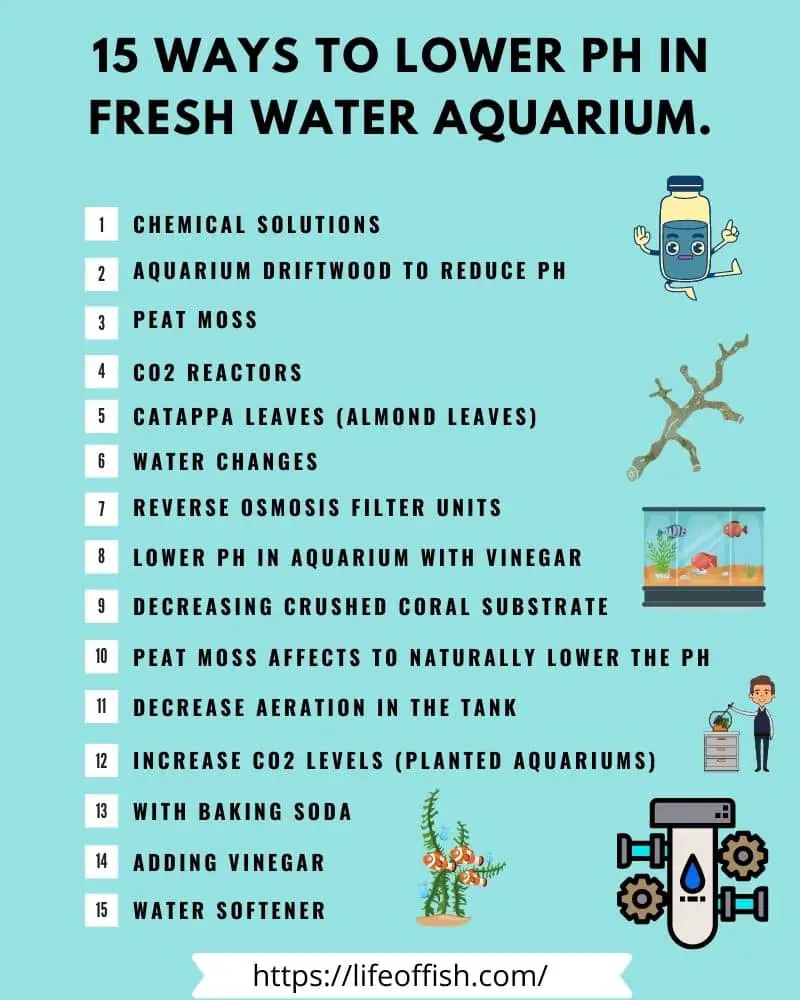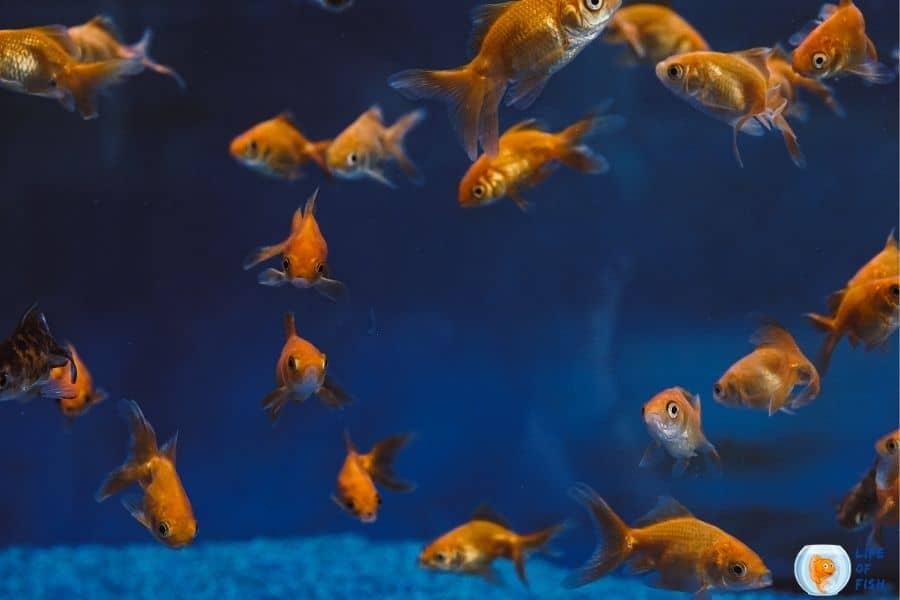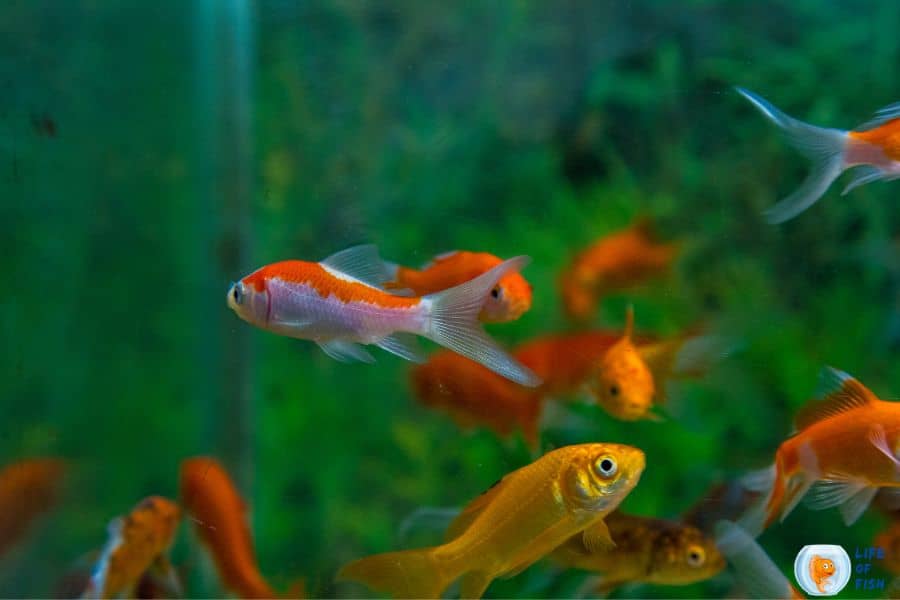For me maintaining an aquarium is both fun and exciting. I have to take care of aquarium fish, and the physical factors affect their health. That includes the amount of oxygen, the presence of ions, and the maintenance of pH levels. In this article I am going to discuss pH levels in aquarium water and how to reduce them, providing a fish-friendly environment.
pH is an indicator that depicts both acidic and primary conditions. the pH of around 7 is neutral. Yes, it’s the pH of the water. pH levels less than 7 are acidic while pH levels above 7 are basic. The acidity excessively increases as levels descend from 7. As the waters’ pH levels are not the same, it is essential to maintain a suitable pH level in an aquarium considering the fish’s pH requirements.

What is pH in freshwater Aquariums?
Jump To
- 1 What is pH in freshwater Aquariums?
- 2 What is the importance of pH?
- 3 When is it necessary to lower the pH level in aquariums?
- 4 Tips on reducing PH in an aquarium
- 5 What causes high pH in the aquarium
- 6 How to monitor or test the water pH in your aquarium
- 7 Type of fish Preferred pH level
- 8 How to lower pH in an aquarium quickly
- 9 What causes the pH to rise in a Freshwater Aquarium?
- 10 How do identify if the PH is not suitable?
- 11 Why pH does not go down in a fish tank?
- 12 Frequently asked questions
Most tropical aquarium fish require a pH of 6.8 to 7.6. But there are some other fish that require lower or higher pH levels in the aquarium. Therefore, it is better to know your fish’s pH requirements to make a healthy environment for them. Depending on what fish you have, you will have to reduce or increase the pH in your fish tanks to give them optimal environmental conditions.

What is the importance of pH?
The pH is a logarithmic scale which uses to measure the acidity or basically of a fluid. It indicates active hydroxide ions (H+) in a solution and has a range of 1 to 14. As pH is a logarithmic scale, changing the pH value from 1 unit will result in a 10-fold change of hydrogen ions in water.
Several factors may affect the pH level of water, such as dissolved chemicals and minerals water, breakdown of organic material in water, etc. Also, You need to have proper knowledge about pH levels because if you do not maintain the required pH level in the water, it can be detrimental to the fish in your tank.
When is it necessary to lower the pH level in aquariums?
If your tank water has a high pH level, it will harm your fish’s gills. As a result, fish may swim back and forth. You need to check the tank water’s pH and take the necessary actions to change the pH level. Otherwise, it can be fatal to your fish.

Ways to lower the pH level in Aquariums (How to adjust aquarium pH)
01. Chemical Solutions
Several chemical solutions are available in the market, comprising diluted acids, tannins, or other organic compounds with acidic behavior. Care should be taken to keep the pH stable. Also, always follow the instructions on the label because each chemical has its own methods to lower the pH. This is an easy way to way to lower pH
02. Aquarium driftwood to reduce pH
By adding Driftwood to your aquarium, you can decorate your tank while lowering pH levels. Due to the release of tannins from Driftwood, the pH level of water will be reduced. But you need to put a sufficient amount of Driftwood to achieve the required outcome of pH or desired effect.
03. Peat Moss
The addition of peat moss or peat pellets to the filter is a standard method used to reduce the aquarium pH level. It also contains tannins, which help to lower the pH level of water. You can use a mesh bag to keep the peat moss contained. Also, It would help if you refilled it when needed.
04. CO2 Reactors
The addition of carbon dioxide to the aquarium water will reduce the pH levels in your tank. CO2 Reactor provides a continuous flow of CO2. Hence, pumping in more CO2 using a CO2 reactor will decrease the pH of your tank water while supplementing plants. It will also help maintain a stable and low pH level as long as the reactor functions.
05. Catappa Leaves (almond leaves)
Catappa leaves can reduce the pH levels in the water. After adding these leaves, it eventually decays and then discharges the tannins. Tannins cause to lowering of the pH in your aquarium. But it can change the watercolor in your tank and change water quality.
But add them gradually to your tanks and monitor pH /KH and water parameters change carefully. Yes, these leaves can release compounds that can reduce the pH in aquariums, but if you add these leaves to the system with hard water, the effect will be minimal due to hard water’s higher buffering capacity. You may need a water softener.
06. Water Changes
It is essential to partial water change the water in your tank to reduce the elevated ammonia level. You have to remove fish fecal matter and excess food from your tank. Cleaning of decorations and gravel is essential as they may also contain debris.
07. Reverse Osmosis Filter Units
A reverse Osmosis water filter helps to maintain a stable pH level by using a semipermeable membrane. Through this, reverse osmosis (RO) is filtering out 90-99% of water impurities, including arsenic, pesticides, and heavy metals. But this system can be expansive and difficult to maintain
08. Lower pH in Aquarium with Vinegar
Vinegar helps to lower the pH level of your aquarium. It occurs in two-stage. Ionization will happen in the first stage. It is the process of releasing hydrogen ions. Over the next few hours, acetic acid and oxygen convert into carbon dioxide. As a result, pH is decreased. But make sure to add the correct amount of vinegar to your tank while measuring pH occasionally.
09. Decreasing crushed coral or dolomite gravel for substrate
When dissolving crushed coral, it is adding calcium-bicarbonate into the water. It causes to increase in the pH level. Therefore, you can lower the pH by adding coral sand or coral decorations.
10. Peat Moss affects to Naturally Lower the pH
Peat Moss has tannins and it causes to lower the pH level in your aquarium. You can keep this in a mesh media bag. When designing your aquarium, you should use only peat products. Then you can replenish your requirement to maintain the expected pH level.
11. Decrease Aeration in the tank
This is a fundamental method to decrease the pH level. When decreasing the oxygen level and causes to increase in the carbon dioxide level spontaneously. As a result of this, pH is lower. But if your tank is highly stocked, this method is not stable because it can affect fish.
12. Increase CO2 levels (planted aquariums)
CO2 is released from fish respiration and CO2 mixes with water. Thus, the pH level is lower. On the other hand, plants absorb CO2 for photosynthesis.
13. Adding RO water
Reverse osmosis (OR) or deionized water is used to create the desired pH and provide buffering. You should always check the pH level of water before adding it to the aquarium.
14. High pH in the aquarium with baking soda
Sodium bicarbonate /baking soda can increase pH levels. The safe amount is 1 teaspoon of baking soda per 5 gallons. It is best to remove fish before adding baking soda. Once the pH has reached the desired level, you can reintroduce it to the aquarium fish.
15. Adding vinegar to lower pH in the aquarium
You can lower the pH level by adding vinegar. If your pH is high, water has more dissolved basic or alkaline mineral constituents. Therefore, anything with a lower pH means that they have more acid and helps to bring the pH lower. But please ensure that it is useable in the aquarium. You should not use more than 1 ml of vinegar per gallon of water.

Tips on reducing PH in an aquarium
Avoid using tap water directly to the fish tank. Store water at another place and leave for 1 to 3 days. This step is essential to minimize and maintain proper PH values. It’s ideal for changing the water in the tank to avoid changes in acidity and the basicity of water. The reduction of carbon dioxide levels increases the PH level, so remember to maintain them.
Also remember to remove rotten fish food, dead plant materials, and waste materials to maintain the PH levels. The addition of limestone, seashells, or coral reef parts will reduce the acidity while maintaining the PH level. Addition of oxygen and lowering of dissolved carbon dioxide. Certainly, the addition of baking soda in the required amounts can reduce PH in an aquarium.
What causes high pH in the aquarium
There are many reasons. Rocks and gravel in your aquarium cause high pH levels by dissolving the pH in the aquarium calcium of those rocks and gravel into your tank. Another reason for raising the level is because of the plants in your tank. When these plants absorb carbon dioxide, the pH rises. Aerating causes to escape carbon dioxide, and as a result, the pH rises.
How to monitor or test the water pH in your aquarium
Aquarium pH test kit
Adds some water to the test tube and add the drop of a testing solution. Then match the color of the water with the ID card to know the pH level.
- Freshwater aquarium pH test kit
- The saltwater high-range test kit
- The wide range of test kit
pH test paper
Test strips or litmus paper change their color depending on how acidic or alkaline the substance is. Hydrion pH paper
Digital pH meter
This is the most accurate pH testing. This can read any pH level’s accuracy within 0.1. Apera instruments pH pocket pen
What is the Best pH For My Fish?
The below table indicates the preferred pH levels of some freshwater fish.
Type of fish Preferred pH level
| Type of fish | Preferred pH level |
|---|---|
| Angelfish | 6.5 – 7.0 |
| Clown Loach | 6.0 – 6.5 |
| Goldfish | 7.0 – 7.5 |
| Harlequin Rasbora | 6.0 – 6.5 |
| Hatchet fish | 6.0 – 7.0 |
| Neon Tetra | 5.8 – 6.2 |
| Plecostomus | 5.0 – 7.0 |
| Silver Dollar | 6.0 – 7.0 |
| Tiger Barb | 6.0 – 6.5 |
| Zebra Danio | 6.5 – 7.0 |
How to lower pH in an aquarium quickly
Almond leaves/ Catappa are the best way to reduce pH levels. This has components like tannins that can quickly lower the pH level. Further, you can use reverse osmosis to lower the pH level. It removes many ions and molecules in the water, and it causes to reduce the pH level.
Another way is decreasing aeration. This reduces the oxygen level, and it causes to increase in CO2 level spontaneously. As a result, the pH is decreased. Vinegar also lowers the pH level. Vinegar includes acetic acid. Acetic acid combines with oxygen in the water and converts it into CO2.
What causes the pH to rise in a Freshwater Aquarium?
Baking soda can increase the pH level. The Standard is 1 teaspoon of baking soda per 5 gallons. This needs to be added continuously. Another way is changing the water. Because over time, the pH level is decreasing. By adding rocks or substrates, you can have a high pH level. Because they are rich in calcium, and then they dissolve and mix it into the water. Aquatic plants also cause to increase in pH levels by trapping carbon dioxide. Aerating allows escaping carbon dioxide; it also increases the pH level.
How do identify if the PH is not suitable?
Fish show the following behaviors as the water becomes not suitable for them. If you witness any of these activities, Reduce or increase PH in an aquarium to a suitable level.
- Fish begin to jump out of the water and swim unconsciously.
- Also, they come close to the upper level of the fish tank.
- Indeed the body begins to itch; therefore, they scratch and rub their body on other objects.
- The skin color changes, indeed becoming black or blue.
- The movements of the gills increase
- Begin to move and swim rapidly in the tank. (Check the pH levels immediately and reduce or increase pH levels to a suitable level)
- Begin to quarrel with each other and try to harm objects.
- Fins and body look pale and dull.
Why pH does not go down in a fish tank?
As neutral water comprises the same amount of hydrogen (H+) ions and hydroxide (OH-) irons, it has a pH value of 7. Water becomes more acidic or basic when the pH value varies from 7. When your tanks contain components that can increase the pH level, such as aquarium plants, rocks and corals, and fish waste. It does not cause to lower the pH

Frequently asked questions
Will high pH kill fish?
Yes, because most of the ammonium in the water converts into toxic ammonia (NH3) at a high pH level (>9). It can kill fish.
Ammonia build-up in water can raise the pH level too high
The total ammonia in your tank is a combination of ammonium ions (NH4 +) and ammonia ions (NH3+). The key factor for the relative concentration of these two compounds is the pH of your water. Alkaline water (pH > 7) contains more ammonia.
Does aquarium gravel raise pH?
Yes, limestone contains calcium and it can lower the pH level.
What influences the pH in the aquarium?
Rock and stones, aquarium plants, water filters, fish wastes, and reverse omission can influence the aquarium’s pH.
Decreased aeration will lower the pH
Yes, Decrease aeration reduced the oxygen level of water. Thus respiratory fish CO2 is well mixed with tank water, and it causes to lower pH.
Driftwood will lower the pH in the water
Driftwood discharges tannins into the water, reducing the pH
Adding CO2 will lower the pH
CO2 reacts with the water and converts into H and bicarbonates. It can lower the pH
High nitrates can cause a drop in the pH level
Yes, the higher concentration of nitrates causes to make the water acidic. Thus the pH level becomes lower.
Pollutants and waste in the water reduce the pH
Yes, fecal matter includes nitrates and ammonia, etc. These are acidic and cause lower pH levels.
Can crush coral (substrate or ornaments) will increase the pH-
Yes. it dissolves and adds calcium to the water.
Can hard water cause higher pH levels?
Yes. Hard water has a high mineral, and it increases the pH level.
Can water purifier lower pH levels (good with hard water)
Yes. Because it removes minerals in the water.
Overstocked aquariums can decrease the pH level
Yes. It causes to increase the fish waste. Fish fecal matters consist of many components to reduce the pH.
Read more on the Aquarium guide
Read more on How Long Does Water Take to Dechlorinate?

Comments are closed.